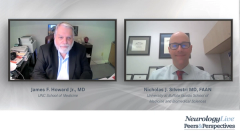
Misdiagnosis Associated With Myasthenia Gravis and Importance of Multidisciplinary Teams
Expert panelists discuss misdiagnosis of myasthenia gravis and consider the question of whether this condition should be treated by community physicians.
Episodes in this series

Dr. James F. Howard: In your experience, what leads to misdiagnosis?
Dr. Nicholas J. Silvestri: I think milder infrequent symptoms often that can be overlooked by the doc or sometimes even patients. I have got patients that have come back and said, oh, in retrospect, actually, I have been having these symptoms for a couple of years now, and I just thought it was maybe eye irritation or allergies or something along those lines. I think milder symptoms, I think, age of the patient, and healthcare literacy, I think sometimes can play a role. I think there are some patients who like you referred to are on social media and they're there three days later with their diagnosis. And there are other patients who I think either want to believe that nothing's wrong or really don't advocate for themselves maybe as strongly as they should. I'll tell you in the hospital when patients come in with symptoms of myasthenia, initially, they're always ruled out for stroke. I don't know why that is. It seems to be the number one diagnosis people get, and then they're told, oh, you don't have a stroke. You actually have myasthenia, which can be a little worrisome too, until that diagnosis is made. Those are just some of the things I've seen over the past couple of years.
Dr. James F. Howard: Yeah. In our practice is much the same. The other interesting ones are those who have ptosis only and get labeled as bell's palsy. And the patient with myotonic dystrophy with bilateral ptosis, our thoracic surgeons call us. We now see any patient being referred in for thymectomy because they've been burned in the past. And I think it boils down from a physician's perspective that they've not taken an accurate critical history searching for that fluctuating nature. And given the busy time of everyone's practice, that often gets overlooked. The details aren't obtained, hence the misdiagnosis. And there's a flip side that we see with the - because of social media, patients come to us insistent that they have myasthenia who clearly do not. And fatigue of some sort, fibromyalgia, if I can use that term. And there is much of a problem in trying to un-establish a diagnosis as we do have and trying to make a diagnosis in some folks. And I don't know if you see that as well.
Dr. Nicholas J. Silvestri: Absolutely. I see it on both ends of the spectrum. We have patients that have fatigue and really not much in the way of other symptomatology to go along with a diagnosis. And then it's trying to chase that to see where that might be. But one of the more recent cases that was referred to me for myasthenia was given the diagnosis of serial negative myasthenia; was actually a patient that had chronic progressive external ophthalmoplegia, CPEO, that we were able to confirm genetically. There are two ends of that spectrum, right? There's the patient with nondescript symptoms and maybe, maybe not a neurological diagnosis, but then the other flip side are patients like you mentioned with myotonic dystrophy or CPEO that can look like myasthenia or oculopharyngeal muscular dystrophy. Now, I haven't seen a case of that in a while, but that's another potential misdiagnosis. Or even I had a patient, one of my patients with Kennedy's disease was initially thought to have myasthenia. Different neurological disorders can be mistaken, but I think it's really that history, as you talked about fatigability of intermittent symptoms that I think distinguish myasthenia from pretty much all the other diseases that I mentioned.
Dr. James F. Howard: Right. And all that has neuromuscular jitter, say on single-fiber gene is not myasthenia. And CPOE is a prime example where they have increased jitter, but it's the history that differentiates it. Should community physicians be the sole provider of patients with myasthenia?
Dr. Nicholas J. Silvestri: Well, that's a very controversial question, Dr. Howard. I think it depends on the case, right? I think that in complicated patients, patients with severe disease, patients with frequent crises, probably not. On the other hand, I think patients with more mild or well-controlled disease, sure. I don't envy the job of community neurologists, general neurologists. They've got a lot of different types of patients to see. You got to keep up to date in a lot of different areas of neurology. And so, I think that's fantastic, but I do think that patients with a complicated case of myasthenia probably should be seen by specialists much as we would expect, let's say a patient with ALS to be seen by a specialist.
Dr. James F. Howard: What about internists, family practice docs, ophthalmologists out in the community?
Dr. Nicholas J. Silvestri: Well, I think that to speak to your point, I often treat those patients in conjunction with those providers. I'm certainly not going to be treating hypertension. I need rely on primary docs oftentimes to help me with side effects that I'm giving patients on some of the standard therapies. I'd say it's more of like a collaborative effort with those types of physicians than anything else.
Dr. James F. Howard: Yeah, I couldn't agree more. It's a joint venture in this day and age. And we value their input. And one can't be exclusionary. Let's change topics a little bit.
Transcript Edited for Clarity
Newsletter
Keep your finger on the pulse of neurology—subscribe to NeurologyLive for expert interviews, new data, and breakthrough treatment updates.























